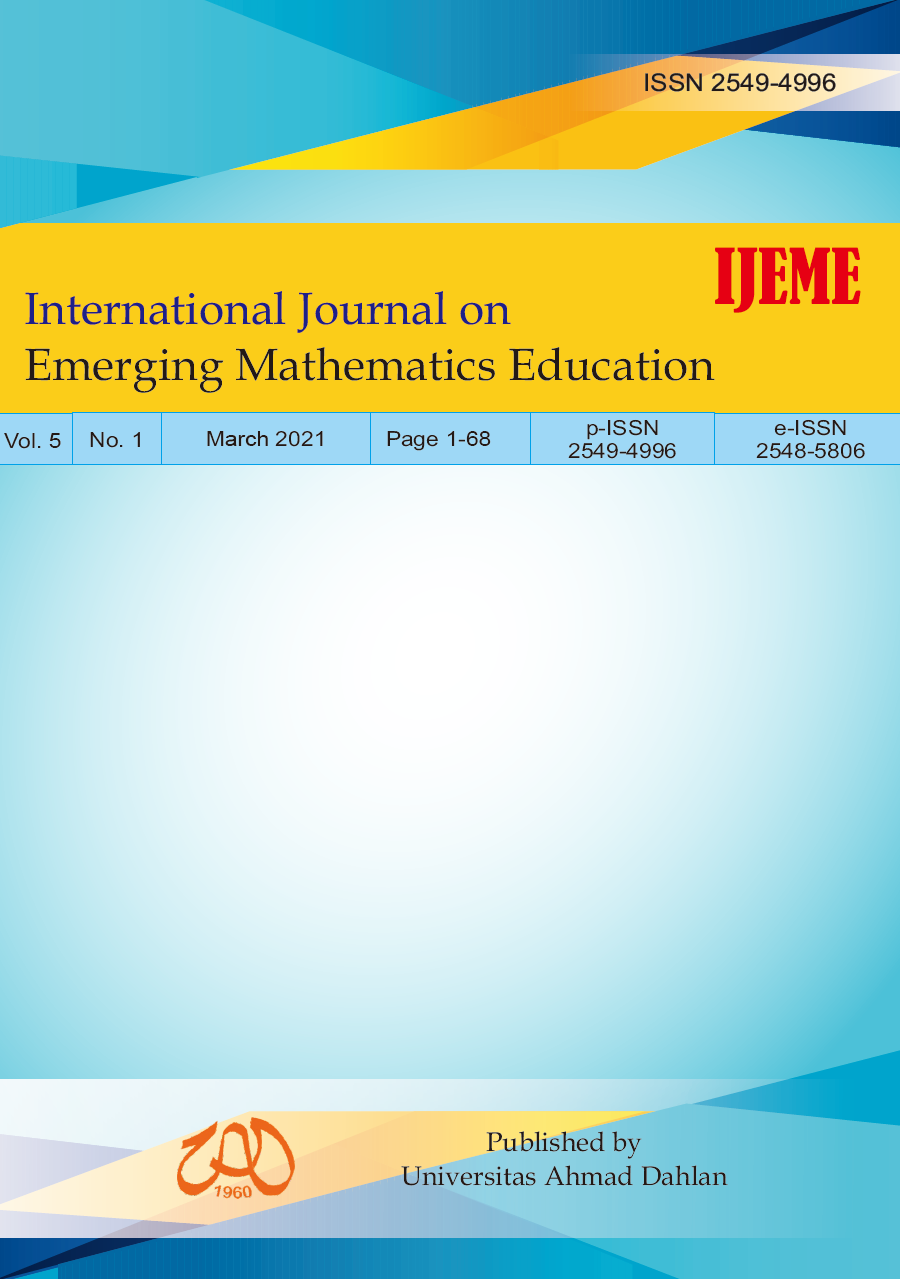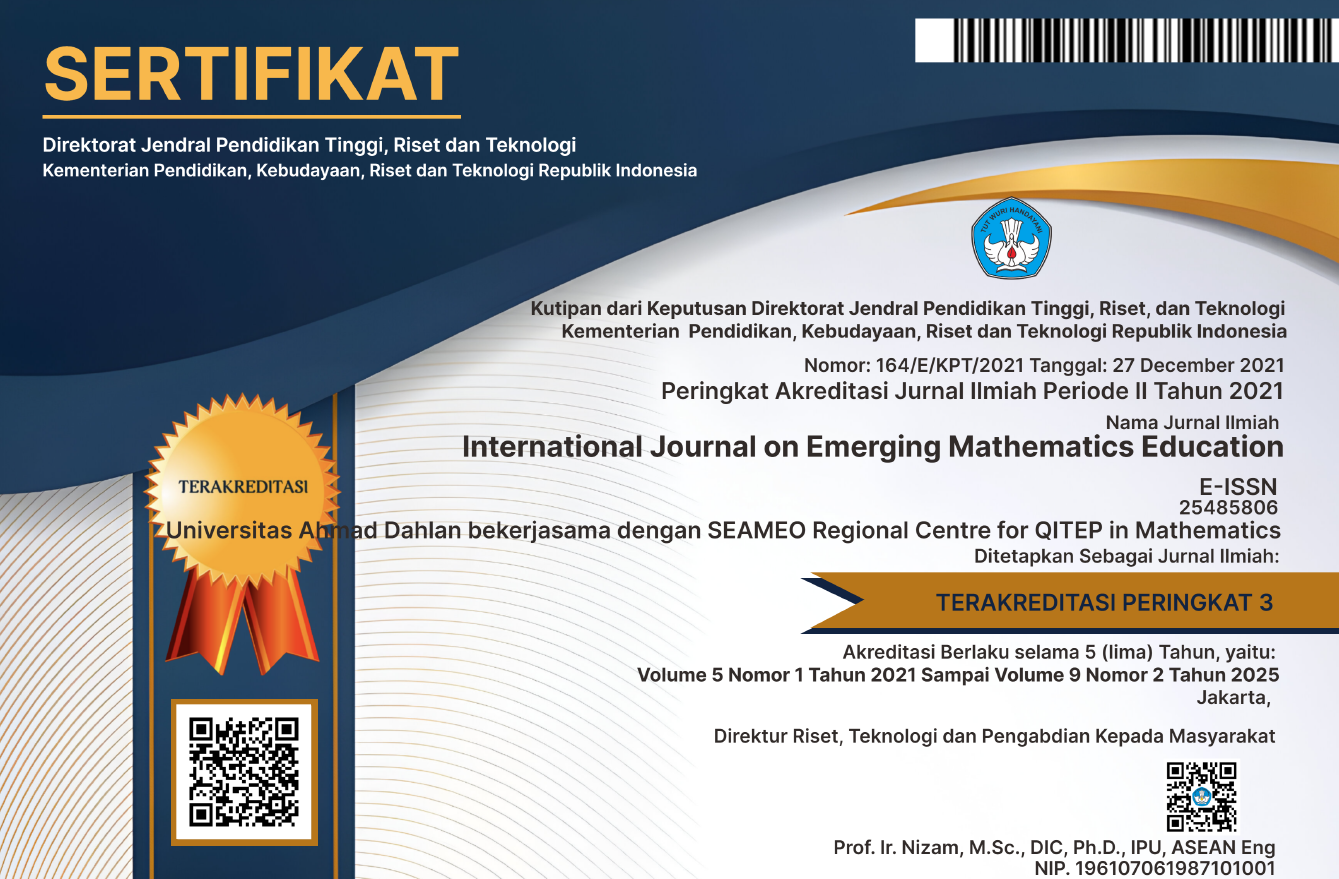Spatial Reasoning: A Survey on the 8th Grader Students' Gain in Online Learning
DOI:
https://doi.org/10.12928/ijeme.v5i1.20140Keywords:
gender, online learning, spatial reasoningAbstract
Coronaviruses disease (Covid-19) pandemic forces schools to implement schools from home through online learning. This study aims to describe online mathematics learning, examine differences in aspects of spatial reasoning, and spatial reasoning based on gender. We conducted a survey method on 140 participants in one private junior high school in Yogyakarta. Data collection using an spatial reasoning test via Google Form consist of nine questions and direct interview with a teacher through video conference. Data analysis uses descriptive and inferential statistics. The results showed that online mathematics learning using the Google Form platform can assist students with limited facilities in learning process. The research finding showed no difference in spatial reasoning ability between male and female students, including in each aspect of spatial reasoning. In addition, other findings indicate that the aspect of spatial reasoning that students master the most is spatial visualization, while the aspect of spatial reasoning that is the least mastered by students is spatial relations.
References
Basilaia, G., & Kvavadze, D. (2020). Transition to Online Education in Schools during a SARS-CoV-2 Coronavirus (COVID-19) Pandemic in Georgia. Pedagogical Research, 5(4).
Buckley, J., Seery, N., & Canty, D. (2018). A Heuristic Framework of Spatial Ability: a Review and Synthesis of Spatial Factor Literature to Support its Translation into STEM Education. Educational Psychology Review, 30(3), 947-972.
Carbonell Carrera, C., Saorín, J. L., & Hess Medler, S. (2018). Pokémon GO and improvement in spatial orientation skills. Journal of Geography, 117(6), 245-253.
Creswell, J. W. (2015). Riset Pendidikan: Perencanaan, Pelaksanaan, dan Evaluasi Riset Kualitatif dan Kuantitatif. Diterjemahkan oleh Helly Soetjipto & Sri Mulyantini Soetjipto. Pustaka Pelajar.
Favale, T., Soro, F., Trevisan, M., Drago, I., & Mellia, M. (2020). Campus traffic and e-Learning during COVID-19 Pandemic. Computer Networks, 176, 107290.
Gagnier, K. M., Atit, K., Ormand, C. J., & Shipley, T. F. (2017). Comprehending 3D Diagrams: Sketching to Support Spatial Reasoning. Topics in Cognitive Science, 9, 883-901.
Habibi, A., Mukminin, A., Riyanto, Y., Prasojo, L. D., Sulistiyo, U., Sofwan, M., & Saudagar, F. (2018). Building an online community: Student teachers' perceptions on the advantages of using social networking services in a teacher education program. Turkish Online Journal of Distance Education, 19(1), 46-61.
Harris, D., & Lowrie, T. (2018). The Distinction Between Mathematics and Spatial Reasoning in Assessment: Do STEM Educators and Cognitive Psychologists Agree? January, 376-383.
Hartatiana, H., Darhim, D., & Nurlaelah, E. (2017). Improving Junior High School Students' Spatial Reasoning Ability Through Model Eliciting Activities with Cabri 3D. International Education Studies, 11(1), 148-154.
Hawes, Z., Moss, J., Caswell, B., Naqvi, S., & MacKinnon, S. (2017). Enhancing Children's Spatial and Numerical Skills through a Dynamic Spatial Approach to Early Geometry Instruction: Effects of a 32-Week Intervention. Cognition and Instruction, 35(3), 236-264.
Javaid, M., Haleem, A., Vaishya, R., Bahl, S., Suman, R., & Vaish, A. (2020). Industry 4.0 technologies and their applications in fighting COVID-19 pandemic. Diabetes and Metabolic Syndrome: Clinical Research and Reviews, 14(4), 419-422.
Legewie, J., & DiPrete, T. A. (2012). School context and the gender gap in educational achievement. American Sociological Review, 77(3), 463-485.
Lowrie, T., Harris, D., Logan, T., & Hegarty, M. (2019). The Impact of a Spatial Intervention Program on Students' Spatial Reasoning and Mathematics Performance. Journal of Experimental Education, 1-19.
Lowrie, T., Logan, T., & Ramful, A. (2016). Spatial Reasoning Influences Students' Performance on Mathematics Tasks. Mathematics Education Research Group of Australasia, 407-414.
Maeda, Y., & Yoon, S. Y. (2013). A Meta-Analysis on Gender Differences in Mental Rotation Ability Measured by the Purdue Spatial Visualization Tests: Visualization of Rotations (PSVT:R). Educational Psychology Review, 25(1), 69-94.
MOEC. (2018). Permendikbud Nomor 35 Tahun 2018 Tentang Perubahan Atas Peraturan Mentri Pendidikan Dan Kebudayaan Nomor 58 Tahun 2014 Tentang Kurilkulum Sekolah Enengah Pertama/ Madrasah Tsanawiyah. Jakarta: Indonesian Ministry of Education and Culture.
Mulligan, J. (2015). Looking within and beyond the geometry curriculum: connecting spatial reasoning to mathematics learning. ZDM, 47(3), 511-517.
Mulligan, J., Woolcott, G., Mitchelmore, M., & Davis, B. (2018). Connecting mathematics learning through spatial reasoning. Mathematics Education Research Journal.
Newcombe, N. S, Booth, J. L., & Gunderson, E. A. (2019). Spatiall Skill, Reasoning, and Mathematics. In J. Dunlosky & K. A. Rawson (Eds.), The Cambridge handbook of cognition and education (pp. 100-123). Cambridge University Press.
Newcombe, N. S. (2010). Picture This: Increasing Math and Science Learning by Improving Spatial Thinking. American Educator, 34(2), 29-43.
Özerem, A. (2012). Misconceptions In Geometry And Suggested Solutions For Seventh Grade Students. Procedia - Social and Behavioral Sciences, 55, 720-729.
Pittalis, M., & Christou, C. (2010). Types of reasoning in 3D geometry thinking and their relation with spatial ability. 191-212.
Radwan, A., & Radwan, E. (2020). Social and Economic Impact of School Closure during the Outbreak of the COVID-19 Pandemic: A Quick Online Survey in the Gaza Strip. Pedagogical Research, 5(4), em0068.
Ramful, A., Lowrie, T., & Logan, T. (2017). Measurement of Spatial Ability: Construction and Validation of the Spatial Reasoning Instrument for Middle School Students. Journal of Psychoeducational Assessment, 35(7), 709-727.
Reilly, D., & Neumann, D. L. (2013). Gender-Role Differences in Spatial Ability: A Meta-Analytic Review. Sex Roles, 68(9-10), 521-535.
Septia, T., Prahmana, R. C. I., Pebrianto, & Wahyu, R. (2018). Improving students spatial reasoning with course lab. Journal on Mathematics Education, 9(2), 327-336.
Sinclair, N., & Bruce, C. D. (2014). Spatial Reasoning for Young Learners. Proceedings of the Joint Meeting 1 - 173 of PME 38 and PME-NA 36, 1(September), 173-203.
Sintema, E. J. (2020). Effect of COVID-19 on the performance of grade 12 students: Implications for STEM education. Eurasia Journal of Mathematics, Science and Technology Education, 16(7), 1-6.
Sutherland, P. (2018). Mechanisms of Emergence: Influence of Open Student Responses Collected Using an Online Survey Tool in Mathematics Classrooms. Philosophy of Mathematics Education Journal, 33, 1-185.
Tan Sisman, G., & Aksu, M. (2016). A Study on Sixth Grade Students' Misconceptions and Errors in Spatial Measurement: Length, Area, and Volume. International Journal of Science and Mathematics Education, 14, 1293-1319.
Uttal, D. H., Meadow, N. G., Tipton, E., Hand, L. L., Alden, A. R., Warren, C., & Newcombe, N. S. (2013). The malleability of spatial skills: A meta-analysis of training studies. Psychological Bulletin, 139(2), 352-402.
Viner, R. M., Russell, S. J., Croker, H., Packer, J., Ward, J., Stansfield, C., Mytton, O., Bonell, C., & Booy, R. (2020). School closure and management practices during coronavirus outbreaks including COVID-19: a rapid systematic review. In The Lancet Child and Adolescent Health (Vol. 4, Issue 5, pp. 397-404). Elsevier B.V.
Zancada-Menendez, C., Sampedro-Piquero, P., Lopez, L., & McNamara, T. P. (2016). Age and gender differences in spatial perspective taking. Aging Clinical and Experimental Research, 28(2), 289-296.
Zayapragassarazan, Z. (2020). COVID-19: Strategies for Online Engagement of Remote Learners. F1000Research, 246, 1-11.
Zhang, W., Wang, Y., Yang, L., & Wang, C. (2020). Risk and Financial Management Editorial Suspending Classes Without Stopping Learning: China's Education Emergency Management Policy in the COVID-19 Outbreak. Journal of Rick and Financial Management, 13(3), 55.
Downloads
Published
How to Cite
Issue
Section
License
License and Copyright Agreement
In submitting the manuscript to the journal, the authors certify that:
- They are authorized by their co-authors to enter into these arrangements.
- The work described has not been formally published before, except in the form of an abstract or as part of a published lecture, review, thesis, or overlay journal. Please also carefully read the International Journal on Emerging Mathematics Education (IJEME) Author Guidelines at http://journal.uad.ac.id/index.php/IJEME/about/submissions#authorGuidelines
- That it is not under consideration for publication elsewhere,
- That its publication has been approved by all the author(s) and by the responsible authorities, tacitly or explicitly, of the institutes where the work has been carried out.
- They secure the right to reproduce any material that has already been published or copyrighted elsewhere.
- They agree to the following license and copyright agreement.
Copyright
Authors who publish with the International Journal on Emerging Mathematics Education (IJEME) agree to the following terms:
- Authors retain copyright and grant the journal the right of first publication with the work simultaneously licensed under a Creative Commons Attribution License (CC BY-SA 4.0) that allows others to share the work with an acknowledgment of the work's authorship and initial publication in this journal.
- Authors are able to enter into separate, additional contractual arrangements for the non-exclusive distribution of the journal's published version of the work (e.g., post it to an institutional repository or publish it in a book), with an acknowledgment of its initial publication in this journal.
- Authors are permitted and encouraged to post their work online (e.g., in institutional repositories or on their website) prior to and during the submission process, as it can lead to productive exchanges, as well as earlier and greater citation of published work.
![]()
Ciptaan disebarluaskan di bawah Lisensi Creative Commons Atribusi-BerbagiSerupa 4.0 Internasional.





